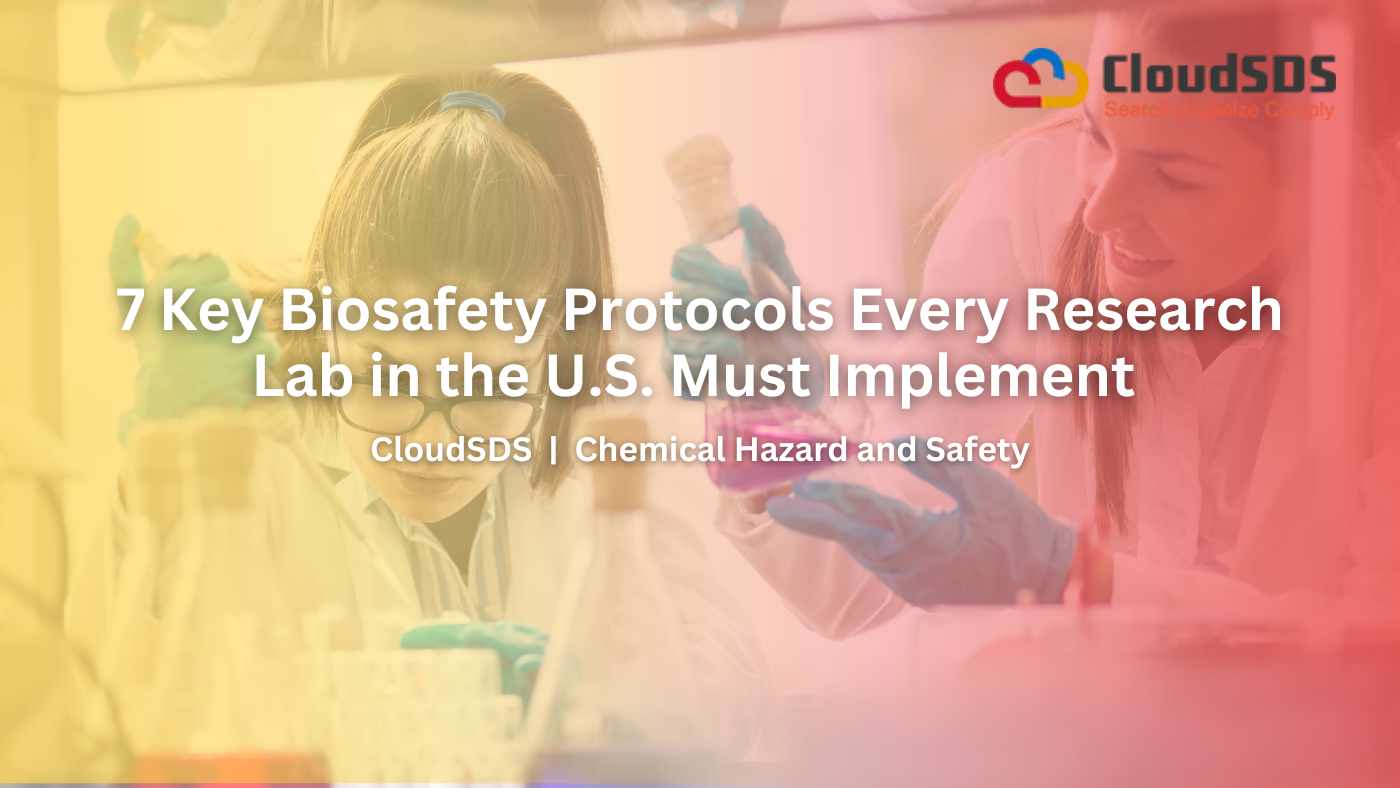Introduction:
In the U.S. research and biotechnology industry, biosafety is not just about following rules; it is essential for responsible science. Laboratories that work with infectious agents, human samples, or genetically modified organisms encounter serious safety and regulatory issues. A small mistake without proper biosafety measures can result in contamination, exposure, or a loss of research credibility.
U.S. agencies like the Centers for Disease Control and Prevention (CDC), National Institutes of Health (NIH), and Occupational Safety and Health Administration (OSHA) set clear biosafety standards through frameworks such as the Biosafety in Microbiological and Biomedical Laboratories (BMBL) and 29 CFR 1910.1450 (OSHA’s Lab Safety Standard).
Importance of Biosafety Protocols in Research sectors
Biosafety protocols are crucial in research sectors. They protect personnel, the environment, and the integrity of scientific work. These protocols ensure the safe handling of infectious agents, prevent accidental exposure, and maintain compliance with standards set by OSHA, CDC, and NIH. Effective biosafety practices, such as risk assessment, proper use of PPE, waste management, and training, reduce contamination risks and promote a culture of safety. For U.S. research institutions, strong biosafety measures not only protect researchers but also maintain public trust and research credibility. This allows innovation to move forward responsibly and ethically within a secure and compliant laboratory environment.
Critical Biosafety Measures Every Lab Must Enforce
1. Conduct Detailed Biosafety Risk Assessments
Every safe lab starts with a solid risk assessment. Before working with any biological material, organizations must identify potential hazards, assess the risk level, and set up the right containment measures.
Key steps include:
- Identify the type of biological agents and classify them under Biosafety Levels (BSL-1 to BSL-4).
- Evaluate exposure routes, such as inhalation, ingestion, or skin contact.
- Assess the effects of exposure on both workers and the environment.
- Review the effectiveness of current safety controls and personal protective equipment (PPE).
- Regularly reassess—especially when new materials or methods are introduced—to stay compliant with CDC and NIH biosafety guidelines.
2. Follow the Appropriate Biosafety Level (BSL) Practices
U.S. laboratories operate under one of four Biosafety Levels (BSL), each with specific containment and procedural requirements.
Each BSL defines the minimum engineering controls, work practices, and PPE required. Labs must be certified and routinely audited to ensure they meet the containment criteria relevant to their operations.
3. Develop and Maintain a Written Biosafety Manual
A biosafety manual is the backbone of your lab’s safety program. It outlines procedures for identifying risks, preventing incidents, and responding to emergencies.
A strong biosafety manual should include: Clear descriptions of biological agents and related hazards. Standard Operating Procedures (SOPs) for handling and disposing of samples. PPE requirements and maintenance schedules for equipment. Guidelines for decontamination and spill response. Procedures for reporting and documentation. According to the CDC’s BMBL, each lab must have a site-specific manual that is reviewed annually and easily accessible to all staff.
4. Train Personnel on Biosafety and Emergency Response
People are the first and last line of defense in biosafety. OSHA requires that every employee who works with biohazards get biosafety training before starting lab work. Effective biosafety training covers: Proper use of biosafety cabinets and containment systems. Identification of exposure routes and risk controls. Procedures for managing spills, sharps injuries, or exposures. Techniques for putting on and taking off PPE. Emergency evacuation drills and reporting channels. Many U.S. organizations use Learning Management Systems (LMS) to provide biosafety training online. This helps ensure consistent, trackable, and audit-ready compliance with OSHA’s training standards.
5. Enforce Strict PPE and Laboratory Hygiene Policies
Personal Protective Equipment (PPE) is crucial for preventing exposure. The type of PPE varies based on the biosafety level and the materials handled.
Essential PPE and hygiene practices include:
- Gloves: Single-use nitrile gloves for sample handling.
- Lab coats or gowns: Fluid-resistant and worn only in the lab.
- Eye and face protection: Safety goggles or face shields for splash protection.
- Respiratory protection: N95 respirators or PAPRs for aerosolized pathogens.
- Hand hygiene: Wash hands before and after using gloves and before leaving the lab. Laboratories must ensure PPE availability, fit testing, and proper disposal to maintain a contamination-free space.
6. Manage Biohazardous Waste and Decontamination Procedures
Safe waste management is not optional—it’s required under the EPA’s Resource Conservation and Recovery Act (RCRA) and state hazardous waste laws. Best practices for managing biohazardous waste include: Separating biological, chemical, and general waste. Using autoclaves or chemical disinfectants for decontamination before disposal. Labeling containers with biohazard symbols and disposal instructions. Keeping waste logs for tracking and EPA audits. Following CDC and OSHA guidelines for handling sharps, contaminated glassware, and liquid waste. A solid decontamination schedule also includes cleaning surfaces with EPA-approved disinfectants, such as sodium hypochlorite or 70% ethanol.
7. Establish a Biosafety Audit and Incident Reporting System
Even with preventive measures in place, incidents can occur. What matters is how quickly and openly the lab reacting.
A solid audit and reporting system should include:
- Immediate isolation and containment of the incident.
- Reporting supervisors and biosafety officers.
- Medical evaluation for exposed staff.
- Documentation and root cause analysis.
- Implementation of corrective and preventive actions (CAPA).
Regular biosafety audits, either internal or by a third party, help to find weaknesses in containment, training, or waste management. Documenting findings and corrective steps ensures long-term compliance and ongoing improvement.
Conclusion
Biosafety is not just about regulations; it’s about responsibility. For U.S. laboratories, staying in line with CDC, NIH, and OSHA standards is crucial for worker safety, public trust, and scientific credibility. By following these seven key biosafety protocols, research organizations can: – reduce the risk of exposure and contamination. They can ensure consistent regulatory compliance. Creating a culture of safety and accountability is also essential. As life sciences, pharmaceuticals, and academic research grow, strong biosafety programs are vital for protecting both science and society. Investing in biosafety management systems, digital training tools, and automated compliance tracking is essential. It forms the basis of responsible research in the U.S.


Leave A Comment